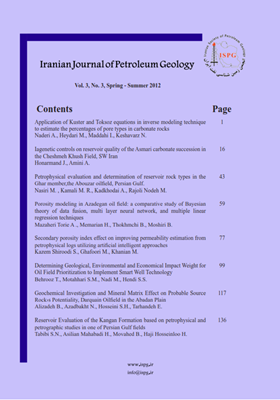-
-
List of Articles
-
Open Access Article
1 - Application of Kuster and Toksoz equations in inverse modeling technique to estimate the percentages of pore types in carbonate rocks
اصغر نادری مصطفی حیدری ایرج مداحی ناصر کشاورز فرج خواه -
Open Access Article
2 - Iagenetic controls on reservoir quality of the Asmari carbonate succession in the Cheshmeh Khush Field, SW Iran
جواد هنرمند عبدالحسین امینی -
Open Access Article
3 - Petrophysical evaluation and determination of reservoir rock types in the Ghar member,the Abouzar oilfield, Persian Gulf.
مهرناز نصیری محمدرضا رجلی نوده -
Open Access Article
4 - Porosity modeling in Azadegan oil field: a comparative study of Bayesian theory of data fusion, multi layer neural network, and multiple linear regression techniques
عطیه مظاهری طرئی حسین معماریان بهزاد تخم چی بهزاد مشیری -
Open Access Article
5 - Secondary porosity index effect on improving approaches permeability estimation from petrophysical logs utilizing artificial intelligent
سجاد کاظم شیرودی مرتضی خانیان -
Open Access Article
6 - Determining Geological, Environmental and Economical Impact Weight for Oil Field Prioritization to Implement Smart Well Technology
تورج بهروز سید مهدیا مطهری مهدی ندری پری -
Open Access Article
7 - Geochemical Investigation and Mineral Matrix Effect on Probable Source Rock's Potentiality, Darquain Oilfield in the Abadan Plain
بهرام علیزاده نسیم آزاد بخت سید حسین حسینی الهام ترهنده -
Open Access Article
8 - Reservoir Evaluation of the Kangan Formation based on petrophysical and petrographic studies in one of Persian Gulf fields
سید نظام الدین طبیبی حسین اصیلیان مهابادی بهرام موحد حسن حاجی حسنلو
-
The rights to this website are owned by the Raimag Press Management System.
Copyright © 2017-2026







